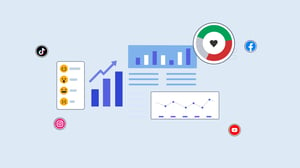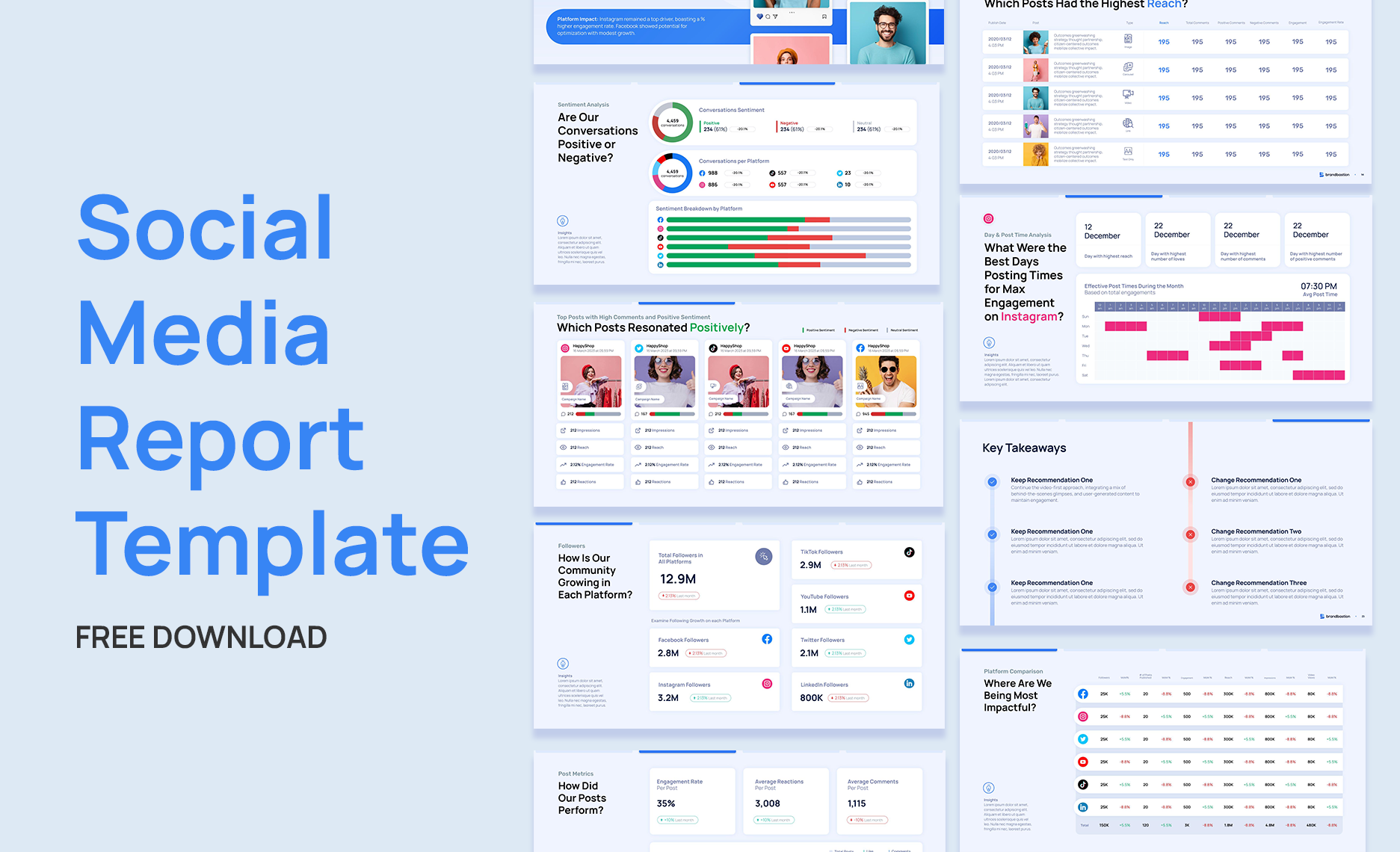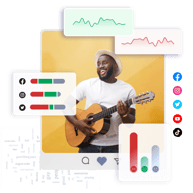
Social Media Reporting: How to Do it Right (+Free Template)
Social media reporting is one of the most important tasks in the social media management process. The reports demonstrate the worth of your work. They also assist you and your team in identifying opportunities for growth and enhancing your brand.
Jump to the social media report example
What is a Social Media Report?
Social media reports help businesses analyze their online presence, engagement, audience growth, and content impact. The reports can analyze data every week, month, or quarter. The goal is to provide insights that help your brand understand not only the numbers and metrics but also their significance.
Why is Social Media Reporting Essential?
Managing social media is complex, and professionals like you are familiar with the challenges that come with it. From illustrating your social media prowess to proving ROI, the art of social media reporting is essential for marketers.
In social media marketing, analytics reports highlight your efforts and help improve future campaigns by providing valuable insights. This practice involves more than just calculations. It also involves understanding your accomplishments and finding ways to improve. By doing so, you can guide your social journey towards success.
Social media reporting is essential for various reasons, as it provides valuable insights and benefits for individuals, businesses, and organizations. Here are some key bullet points highlighting its importance:
- Performance Evaluation. Social media reporting is crucial for assessing the effectiveness of marketing campaigns by tracking metrics like engagement, reach, and conversions.
- Data-Driven Decision Making. It empowers data-driven decisions by offering actionable insights to refine content, schedules, and budgets based on performance data.
- Audience Understanding. Reporting provides insights into audience demographics, preferences, and behaviors, enabling tailored content and strategies.
- Competitive Analysis. It helps benchmark social media performance against competitors, identifying trends and areas for improvement.
- ROI Measurement. Reporting determines which campaigns deliver the best results and where to allocate resources.
- Content Optimization. It guides content strategy by highlighting high-performing content and areas needing improvement.
- Crisis Management. Reporting monitors sentiment to detect potential PR crises, enabling prompt responses.
- Resource Allocation. It identifies high-value social media channels and campaigns, preventing waste of time and resources.
- Compliance and Accountability. Reporting maintains records for compliance and accountability, which is crucial for adhering to regulations and standards.
- Goal Tracking. Reporting tracks progress toward objectives, allowing for strategy adjustments.
- Improves Engagement. It provides insights into the best times to engage with the audience, enhancing user experience.
- Enhances Customer Service. Reporting monitors customer feedback and inquiries, enabling prompt responses and building brand loyalty.
- Adaptation to Trends. It keeps businesses informed about emerging trends and platforms, streamlining adaptation and opportunity capture.
- Long-Term Marketing Strategy Development. It informs the development of long-term strategies, setting realistic goals for sustained success.
How to Craft an Effective Social Media Report
You've sculpted your initial social media strategy, navigated the complex landscape of engagement, and driven campaigns to the forefront. Now, it's time to review, analyze, and share your work in a report. This report should not only summarize KPIs but also help you understand what worked and what needs improvement. This will help your social media strategy grow.
1. Identify Your Target Audience
Determine the intended recipients of your report. Tailor your content to match the interests and needs of your boss, marketing team, or other stakeholders. Customize your approach and type of content to resonate with each specific group.
2. Define Clear Objectives
Begin your reporting journey by setting clear objectives. Are you aiming to increase brand awareness, drive website traffic, or boost engagement? Your report's structure and metrics should align with these goals.
For instance, if your aim is to boost engagement, consider the significance of pinpointing shared characteristics among top-performing posts.
3. Select Key Metrics
A well-rounded social media report covers different metrics like engagement, reach, click-through rates, and conversion data. However, don't overwhelm your report with excessive metrics; focus on those that directly contribute to your objectives. Some social media metrics examples include:
- Reach
- Engagement
- Engagement Rate
- Followers & Follower Growth
- Impressions
- Likes Per Social Media Post
- Comments Per Post
- Comment sentiment
- Tracking “types of comments” (i.e., purchase intent, customer complaints, etc.)
It's crucial to strike a balance between quantitative and qualitative metrics. Given the complexity of social media data, a well-rounded approach ensures a comprehensive understanding.
How your target audience can impact the content focus and metrics to show
| Target Audience | Content Focus | Key Performance Indicators (KPIs) |
|---|---|---|
| Your Manager / CMO |
|
|
| Your Marketing Team |
|
|
| Your client |
|
|
| Your colleagues (wider company) |
|
|
4. Gather Data Sources & Visualize It
Collect data from various social media platforms, assembling the components that make up your social media performance. Each data point plays a role in forming a comprehensive picture of your report. Visual elements, such as charts and graphs, transform raw data into easily digestible insights.
5. Analyze and Interpret
Examine the gathered data to uncover patterns, trends, and insights. Translate raw information into a coherent narrative that guides your audience through the highs and lows of your social media endeavors.
Bonus Tip: Include a Comparative Analysis
To gauge the success of your efforts, include a section that compares your current performance with previous periods. This allows you to identify growth trends and areas that require attention. We’ve included some timeline examples in our sample report below to give you an idea!
6. Craft Your Presentation
Create a well-structured and visually appealing social media analysis report that effectively communicates your findings. Choose a spreadsheet, presentation, or both to make your report clear and interesting when sharing social media insights with your audience.
Downloadable Social Media Analytics Report Template
To make the social media reporting process even easier, we are offering a free social media monthly report. This template serves as an invaluable tool for crafting comprehensive social media marketing reports that showcase your performance.

Want to outsource social media reporting to analytics experts?
Our AI-powered system, in collaboration with our human moderation team, diligently analyzes and categorizes every single comment on your content. We label sentiment, identify harmful content, assess engagement levels, and more, providing you with deep insights into user feedback. Evaluating comment sentiment adds an extra layer to gauge brand favorability and elevate your social media report.
Say, for example, you’re an entertainment brand, and you’re posting about an upcoming title release. You probably want to know the engagement rate, reach, and impressions to help determine the success of your social media campaign.
But you can take it a step further by examining the sentiment expressed in over 10,000 comments on your posts. Which specific posts received a high volume of positive sentiment, and why? Perhaps posts featuring witty dialogue garnered much more positive feedback than those with a more serious tone.
Or maybe there’s a spike in customer complaints experiencing technical issues with your platform. These key themes might go unnoticed in the midst of hundreds or thousands of comments. With BrandBastion Intelligence, you'll gain access to the data you need to genuinely comprehend your audience and their sentiments.

Social media reporting goes beyond numerical figures; it offers a realm of valuable insights that can steer your brand's performance. The fusion of analytics and storytelling is the core of creating impactful reports that inform and influence. As you navigate the landscape of reporting, remember that you're not just presenting data. You're weaving a narrative that propels your brand forward.
Embrace the potential, harness the insights, and craft a vibrant masterpiece of social media accomplishments.